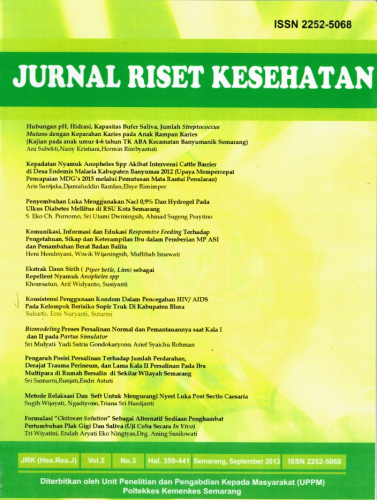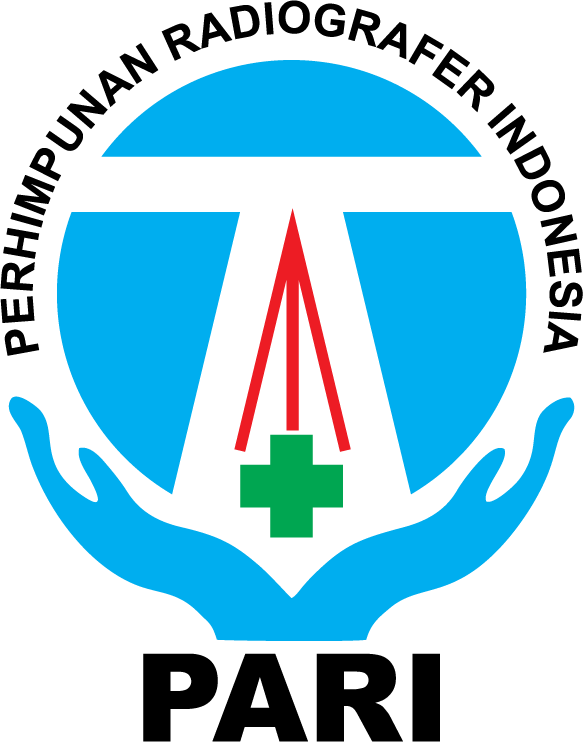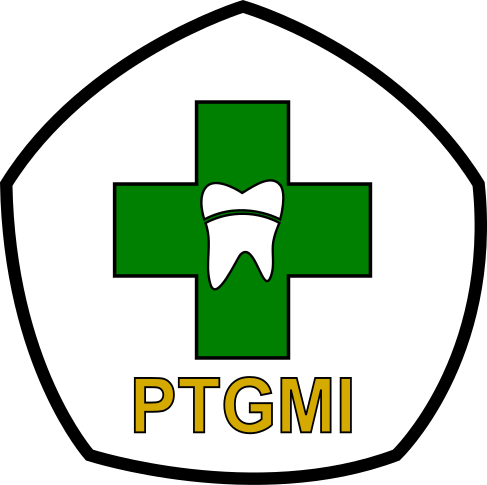NEUTRALIZE BACTERIAL ACTIVITY WITH ANATOMICAL EMBALMING SOLUTIONS
Abstract
Formaldehyde had some degree of toxicity in the human body as a cadaver preservation solution. Recent studies showed that moderate formaldehyde levels in cadavers could neutralize SARS-CoV-2. However, other effects of formaldehyde levels in the air are not yet known on bacteria. This study aims to determine the optimal level of formaldehyde that can be used to neutralize bacteria and is safe for humans. This study used a post-test control group design with formaldehyde level as the independent variable and bacterial colonization as the dependent variable. The results showed that the mean levels of formaldehyde with the bacterial colony respectively were P1 (1.378±0.716; 0.40±0.10), P2 (0.347±0.038; 1.40±0.10), P3 (0.137±0.006; 2.40 ±0.10), P4 (0.042±0.005; 3.32±0.09), and P5 (0.009±0016; 4.40±0.10). The statistical analysis results revealed a value of p<0.05, which indicated that the higher the formaldehyde level, the higher the ability to neutralize bacterial activity. The study concluded the optimum level for neutralizing bacterial activity safe for humans is about 0347±0038 mg/m3.
Keywords
Full Text:
PDFReferences
Adamović, D., Čepić, Z., Adamović, S., Stošić, M., Obrovski, B., Morača, S., & Vojinović Miloradov, M. (2021). Occupational Exposure to Formaldehyde and Cancer Risk Assessment in an Anatomy Laboratory. International Journal of Environmental Research and Public Health, 18(21), 11198. https://doi.org/10.3390/ijerph182111198
Ahmed, H. (2011). Preliminary study: Formaldehyde exposure in laboratories of Sharjah university in UAE. Indian Journal of Occupational and Environmental Medicine, 15(1), 33. https://doi.org/10.4103/0019-5278.82997
Albertini, R. J., & Kaden, D. A. (2017). Do chromosome changes in blood cells implicate formaldehyde as a leukemogen? Critical Reviews in Toxicology, 47(2), 145–184. https://doi.org/10.1080/10408444.2016.1211987
Andersen, M. E., Gentry, P. R., Swenberg, J. A., Mundt, K. A., White, K. W., Thompson, C., … Clewell, H. J. (2019). Considerations for refining the risk assessment process for formaldehyde: Results from an interdisciplinary workshop. Regulatory Toxicology and Pharmacology, 106, 210–223. https://doi.org/10.1016/j.yrtph.2019.04.015
Aung, W.-Y., Sakamoto, H., Sato, A., Yi, E.-E.-P.-N., Thein, Z.-L., Nwe, M.-S., … Mar, O. (2021). Indoor Formaldehyde Concentration, Personal Formaldehyde Exposure and Clinical Symptoms during Anatomy Dissection Sessions, University of Medicine 1, Yangon. International Journal of Environmental Research and Public Health, 18(2), 712. https://doi.org/10.3390/ijerph18020712
Bernardini, L., Barbosa, E., Charão, M. F., Goethel, G., Muller, D., Bau, C., … Brucker, N. (2021). Oxidative damage, inflammation, genotoxic effect, and global DNA methylation caused by inhalation of formaldehyde and the purpose of melatonin. Toxicology Research, 9(6), 778–789. https://doi.org/10.1093/toxres/tfaa079
Bhat, D., Chittoor, H., Murugesh, P., Basavanna, P. N., & Doddaiah, S. (2019). Estimation of occupational formaldehyde exposure in cadaver dissection laboratory and its implications. Anatomy & Cell Biology, 52(4), 419. https://doi.org/10.5115/acb.19.105
Boscolo-Berto, R., Tortorella, C., Porzionato, A., Stecco, C., Picardi, E. E. E., Macchi, V., & De Caro, R. (2021). The additional role of virtual to traditional dissection in teaching anatomy: a randomised controlled trial. Surgical and Radiologic Anatomy, 43(4), 469–479. https://doi.org/10.1007/s00276-020-02551-2
Bou-Nader, C., Stull, F. W., Pecqueur, L., Simon, P., Guérineau, V., Royant, A., … Hamdane, D. (2021). An enzymatic activation of formaldehyde for nucleotide methylation. Nature Communications, 12(1), 4542. https://doi.org/10.1038/s41467-021-24756-8
Cammalleri, V., Pocino, R. N., Marotta, D., Protano, C., Sinibaldi, F., Simonazzi, S., … Vitali, M. (2022). Occupational scenarios and exposure assessment to formaldehyde: A systematic review. Indoor Air, 32(1). https://doi.org/10.1111/ina.12949
Choi, Y. W., Sunderman, M. M., McCauley, M. W., Richter, W. R., Willenberg, Z. J., Wood, J., … Calfee, M. W. (2021). Formaldehyde Vapor Characteristics in Varied Decontamination Environments. Applied Biosafety, 26(1), 33–41. https://doi.org/10.1089/apb.21.926968
Guo, J., Xiong, Y., Kang, T., Zhu, H., Yang, Q., & Qin, C. (2021). Effect of formaldehyde exposure on bacterial communities in simulating indoor environments. Scientific Reports, 11(1), 20575. https://doi.org/10.1038/s41598-021-00197-7
Häcker, I., Koller, R., Eichner, G., Martin, J., Liapi, E., Rühl, J., … Schetelig, M. F. (2020). Evaluation of Hydrogen Peroxide Fumigation and Heat Treatment for Standard Emergency Arthropod Inactivation in BSL-3 Insectaries. Frontiers in Bioengineering and Biotechnology, 8. https://doi.org/10.3389/fbioe.2020.602937
Jung, M., & Smogorzewska, A. (2021). Endogenous formaldehyde destroys blood stem cells. Blood, 137(15), 1988–1990. https://doi.org/10.1182/blood.2020010541
Kang, D. S., Lee, N., Shin, D. Y., Jang, Y. J., Lee, S.-H., Lim, K.-M., … Seo, Y. R. (2022). Network-based integrated analysis for toxic effects of high-concentration formaldehyde inhalation exposure through the toxicogenomic approach. Scientific Reports, 12(1), 5645. https://doi.org/10.1038/s41598-022-09673-0
Li, T., Wei, Y., Qu, M., Mou, L., Miao, J., Xi, M., … He, R. (2021). Formaldehyde and De/Methylation in Age-Related Cognitive Impairment. Genes, 12(6), 913. https://doi.org/10.3390/genes12060913
Lin, N., Rosemberg, M., Li, W., Meza‐Wilson, E., Godwin, C., & Batterman, S. (2021). Occupational exposure and health risks of volatile organic compounds of hotel housekeepers: Field measurements of exposure and health risks. Indoor Air, 31(1), 26–39. https://doi.org/10.1111/ina.12709
Lipskerov, F. A., Sheshukova, E. V., & Komarova, T. V. (2022). Approaches to Formaldehyde Measurement: From Liquid Biological Samples to Cells and Organisms. International Journal of Molecular Sciences, 23(12), 6642. https://doi.org/10.3390/ijms23126642
Nadalutti, C. A., Prasad, R., & Wilson, S. H. (2021). Perspectives on formaldehyde dysregulation: Mitochondrial DNA damage and repair in mammalian cells. DNA Repair, 105, 103134. https://doi.org/10.1016/j.dnarep.2021.103134
Nielsen, G. D., Larsen, S. T., & Wolkoff, P. (2017). Re-evaluation of the WHO (2010) formaldehyde indoor air quality guideline for cancer risk assessment. Archives of Toxicology, 91(1), 35–61. https://doi.org/10.1007/s00204-016-1733-8
Nikolic, P., Mudgil, P., & Whitehall, J. (2020). The in vitro antibacterial effect of permethrin and formaldehyde on Staphylococcus aureus. MicrobiologyOpen, 9(8). https://doi.org/10.1002/mbo3.1054
Owolabi, J. O., Tijani, A. A., & Ihunwo, A. (2022). A Need to Protect the Health and Rights of Anatomists Working in Dissection Laboratories. Risk Management and Healthcare Policy, Volume 15, 889–893. https://doi.org/10.2147/RMHP.S362305
Quondamatteo, F., Corzo‐Leon, D. E., Brassett, C., Colquhoun, I., Davies, D. C., Dockery, P., … Parson, S. H. (2021). Neutralisation of SARS‐CoV‐2 by anatomical embalming solutions. Journal of Anatomy, 239(5), 1221–1225. https://doi.org/10.1111/joa.13549
Stuart, J., Chewins, J., & Tearle, J. (2020). Comparing the Efficacy of Formaldehyde with Hydrogen Peroxide Fumigation on Infectious Bronchitis Virus. Applied Biosafety, 25(2), 83–89. https://doi.org/10.1177/1535676020909998
Thompson, B., Green, E., Scotcher, K., & Keenan, I. D. (2022). A Novel Cadaveric Embalming Technique for Enhancing Visualisation of Human Anatomy. https://doi.org/10.1007/978-3-030-87779-8_13
Umansky, C., Morellato, A. E., & Pontel, L. B. (2021). Illuminating cellular formaldehyde. Nature Communications, 12(1), 580. https://doi.org/10.1038/s41467-020-20758-0
Woolston, B. M., Roth, T., Kohale, I., Liu, D. R., & Stephanopoulos, G. (2018). Development of a formaldehyde biosensor with application to synthetic methylotrophy. Biotechnology and Bioengineering, 115(1), 206–215. https://doi.org/10.1002/bit.26455
DOI: https://doi.org/10.31983/jrk.v11i2.9234
Article Metrics
Refbacks
- There are currently no refbacks.
Copyright (c) 2022 Jurnal Riset Kesehatan




















































